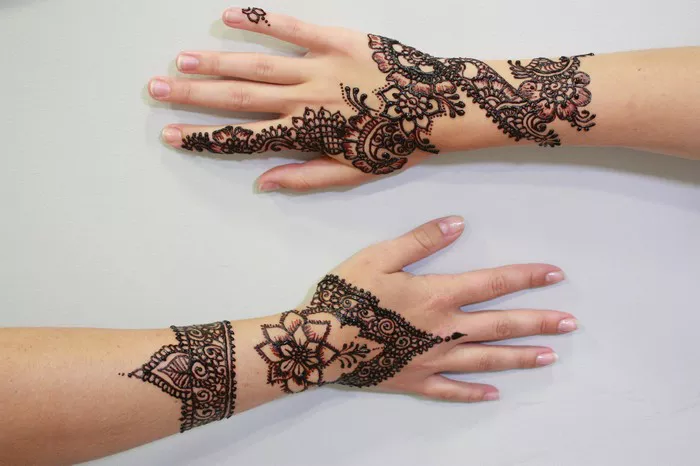Henna tattoos have become increasingly popular for their beautiful designs and temporary nature. Whether for cultural events, festivals, or personal adornment, henna offers a unique way to decorate the skin. One common question that arises is: “How long does it take to get a henna tattoo?” This article delves into the factors affecting the time required for henna application, the process involved, and tips for achieving the best results.
What is Henna?
Henna, derived from the Lawsonia inermis plant, is a natural dye that has been used for centuries in various cultures, primarily in the Middle East, India, and Africa. The leaves are dried, ground into a fine powder, and mixed with liquids to create a paste. When applied to the skin, henna leaves a temporary stain that ranges from orange to deep reddish-brown.
Factors Influencing Henna Application Time
Several factors influence how long it takes to apply a henna tattoo. These include:
1. Design Complexity
The complexity of the henna design is one of the most significant factors. Simple designs, such as small flowers or basic geometric patterns, can take as little as 10-15 minutes. In contrast, intricate designs featuring detailed motifs, shading, and larger areas can take several hours.
2. Size of the Tattoo
Larger designs naturally require more time than smaller ones. A small henna tattoo on the hand or foot might take 20-30 minutes, while a full-hand or full-foot design could take 1-2 hours. Full-body henna, often done for brides in traditional ceremonies, can take 4-6 hours or more.
3. Artist’s Skill Level
An experienced henna artist can work more quickly and efficiently than someone who is less practiced. Skilled artists have a steady hand and a deep understanding of design techniques, allowing them to create intricate patterns faster.
4. Henna Consistency and Quality
The consistency and quality of the henna paste also play a role. Fresh, high-quality henna paste that is smooth and free of clumps is easier to apply and adheres better to the skin, making the application process smoother and faster.
5. Environmental Conditions
The environment can impact the drying time of henna. Warm and dry conditions speed up the drying process, while humid or cool environments may slow it down. Proper preparation, such as ensuring the skin is clean and free of oils, can also affect how quickly the henna sets.
The Henna Application Process
Understanding the henna application process can help manage expectations regarding the time required. Here’s a step-by-step overview:
1. Preparation
Before applying henna, it’s essential to prepare the skin. This involves cleaning the area with soap and water to remove any oils or lotions. Some artists recommend exfoliating the skin to remove dead cells, which can help the henna adhere better.
2. Mixing the Henna Paste
Henna paste is typically made by mixing henna powder with liquids such as lemon juice, water, or tea, and adding essential oils for fragrance and improved staining. The mixture is then allowed to rest for several hours or overnight to develop the dye.
3. Applying the Design
The artist transfers the henna paste to a cone or applicator bottle to create fine lines and intricate designs. This step’s duration depends on the design’s complexity and the artist’s skill level. Simple designs may take only a few minutes, while elaborate patterns can take hours.
4. Drying and Setting
Once the henna is applied, it needs time to dry and set. This process can take anywhere from 15 minutes to a few hours, depending on the environment and henna consistency. To ensure a darker stain, it’s common to leave the paste on for 4-6 hours or even overnight.
5. Removing the Paste
After the henna has dried and set, it’s time to remove the paste. This can be done by gently scraping it off with a spoon or fingernail. It’s important to avoid using water during this step, as it can weaken the stain. The initial stain will be light but will darken over the next 24-48 hours as it oxidizes.
See Also: How Long After Top Surgery Can I Get a Tattoo?
Tips for a Successful Henna Application
To achieve the best results and ensure a beautiful henna tattoo, consider the following tips:
1. Choose a Skilled Artist
Selecting a skilled and experienced henna artist is crucial for achieving intricate and well-executed designs. Look at the artist’s portfolio and read reviews to ensure they have a good track record.
2. Prepare the Skin Properly
Proper skin preparation can significantly impact the henna stain’s quality. Clean, exfoliate, and dry the skin thoroughly before application.
3. Use High-Quality Henna
High-quality henna paste made from fresh, natural ingredients will yield better results. Avoid black henna, which can contain harmful chemicals.
4. Follow Aftercare Instructions
Aftercare is essential for maintaining the henna stain. Avoid water contact for at least 12 hours after removing the paste, and apply a natural oil like coconut or olive oil to moisturize the skin and protect the stain.
5. Be Patient
Patience is key when it comes to henna tattoos. Allow ample time for the application process, drying, and setting to ensure the best possible outcome.
Conclusion
Getting a henna tattoo can be a beautiful and culturally rich experience, but it requires time and patience. The duration of the process depends on various factors, including the design’s complexity, the size of the tattoo, the artist’s skill level, the quality of the henna paste, and environmental conditions. By understanding these factors and following proper preparation and aftercare steps, you can enjoy a stunning henna tattoo that lasts for weeks.
Whether you’re seeking a simple design or an intricate masterpiece, planning and selecting a skilled artist can ensure a successful and enjoyable henna application experience.

